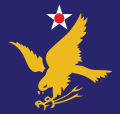History
Background
GHQ Air Force (GHQ, AF) had been established with two major combat functions, to maintain a striking force against long range targets, and the air defense of the United States. [1] In the spring of 1941, the War Department established four strategic defense areas and GHQ, AF reorganized its Northwest Air District as 2nd Air Force with responsibility for air defense planning and organization in the western and northwestern mountains. [2] 2nd Air Force activated 2nd Interceptor Command at Fort George Wright, Washington on 4 June 1941, under the command of Brigadier General Carlyle N. Walsh. Two weeks later, the command moved to Fort Lawton, Washington. [3]
Initial operations in the United States
The attack on Pearl Harbor put all units in the Western Theater of Operations on heightened alert. [4] The command was charged with control of "active agents" for air defense in its area of responsibility, which included interceptor aircraft, antiaircraft artillery and barrage balloons. Civilian organizations provided air raid warnings and enforced blackouts and came under the authority of the Office of Civilian Defense. Radar was initially not sufficiently developed to be included in air defense systems, There were only ten radars to guard the Pacific coast, but the command worked "feverishly" to create a ground observer corps and coastal radar net as elements of its Aircraft Warning Service. [5]
However, it soon became apparent that having two commands responsible for air defense in the Western Theater of Operations was impractical and 4th Interceptor Command was given responsibility for air defense of the entire Pacific coast of the United States, with the 2nd focusing on training. [6] However, 2nd Air Force was assuming a primary mission of training heavy bomber units, [7] and had little need for a fighter organization. In fact, what was now the 2nd Fighter Command had been without any operational fighter components since early 1942. [8] Therefore it was decided that the command would deploy to the Pacific as the fighter headquarters for 5th Air Force, and it was reassigned and redesignated 5th Fighter Command in late August 1942. [3]
Operations in the Pacific
In November 1942, V Fighter Command had deployed to Australia to become the primary command and control organization for Fifth Air Force, fighter units operating primarily in the Southwest Pacific Theater. Its assigned units fought in the Fifth Air Force Area of Responsibility flying cover missions for convoys, patrols, escorted bombers, attacked enemy airfields, and supported ground forces.
Afterward, V Fighter Command served with the occupation force in Japan before being inactivated in 1946. In September 1947, the command was transferred to the United States Air Force (USAF) in inactive status. A year later, in October 1948, USAF disbanded the command. [3]
This page is based on this
Wikipedia article Text is available under the
CC BY-SA 4.0 license; additional terms may apply.
Images, videos and audio are available under their respective licenses.


